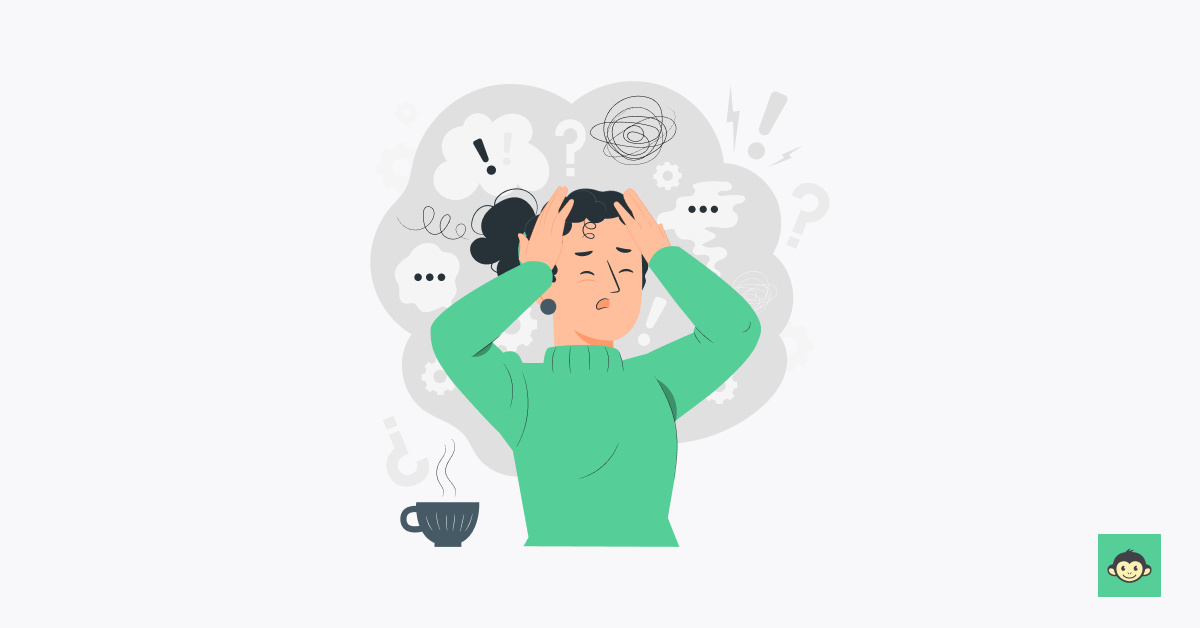How to retain high-performing employees: Answering the million dollar question

Welcome to the world of employee retention, where we aim to unravel the mystery of holding onto high-performing individuals. We often hear the million-dollar question: "How do you retain the best talent?"
In our quest to answer this, we won't be following the well-trodden path; instead, we'll venture into the realm of unconventional strategies that will keep your star employees shining brightly in your organization.
In a business landscape where top talent can be as fleeting as a shooting star, it's vital to understand the keys to keeping your best and brightest right where they belong. In this friendly and conversational exploration, we'll delve into the strategies and insights you need to master the art of employee retention. So, fasten your seatbelts, and let's embark on this journey together.
Why do employees leave in the first place?

Employees embark on their departure for various reasons, and understanding these factors is the first step in enhancing retention.
One significant driver of employee departures is the lack of growth and career opportunities. When high-performing individuals feel their professional development has hit a dead-end, they often start exploring other avenues. It's akin to a plant that wilts without sunlight – employees need room to grow and thrive.
Another key factor is poor management. When employees find themselves working under leaders who don't appreciate their efforts, or worse, exhibit toxic behavior, it becomes a powerful motivator for them to seek greener pastures. People don't leave companies; they leave bosses.
A lack of recognition and appreciation can also drive employees away from most companies. Human beings have an innate desire to be acknowledged and rewarded for their hard work. When this need goes unmet, motivation dwindles, and the idea of a workplace where their contributions are valued becomes alluring.
Mismatched expectations can be a silent killer of employee loyalty. If the job doesn't align with what employees anticipated, whether in terms of responsibilities, work-life balance, or the company culture, they may opt to depart in search of a better fit.
In summary, employees leave due to competitive salaries elsewhere, limited growth opportunities, poor management, a lack of recognition, and misaligned expectations. Addressing these factors is crucial to keeping your talent pool intact and thriving.
Who are high performers in an organization, and how do you spot them?

High performers are the unsung heroes of an organization, the individuals who consistently go above and beyond to achieve exceptional results. They are the ones who drive innovation, exceed expectations, and contribute significantly to a company's success.
To spot high performers, keep an eye out for the following characteristics and behaviors:
- Consistency in excellence: High performers consistently deliver outstanding results. Their work is marked by quality and a commitment to excellence.
- Initiative and proactivity: They don't wait for instructions but proactively identify problems and solutions. They take the lead and inspire their colleagues.
- Adaptability: High performers readily adapt to change and are open to new ideas. They embrace challenges as opportunities for growth.
- Strong work ethic: They exhibit a strong sense of responsibility and take ownership of their tasks. Deadlines are not just met but often exceeded.
- Innovation: These individuals are creative problem-solvers. They come up with fresh ideas and find novel ways to tackle challenges.
- Collaboration: High performers are team players. They collaborate effectively, bringing out the best in their colleagues and contributing to a positive working environment.
- Continuous learning: They have a thirst for knowledge and self-improvement. They seek out opportunities for growth and development.
- Leadership potential: Many high performers have leadership qualities. They naturally influence and inspire others, making them ideal candidates for future leadership roles.
- Positive attitude: They maintain a positive attitude even in challenging situations. Their optimism is contagious and helps uplift the entire team.
- Results-oriented: High performers are focused on outcomes and achieving goals. They don't get bogged down by minor setbacks but stay focused on the bigger picture.
Identifying high performers involves a combination of observing their performance, gathering feedback from peers and supervisors, and considering their impact on the organization as a whole. Once spotted, it's crucial to nurture and retain these invaluable assets.
What do high performers struggle with?

High performers, despite their excellence, are not immune to challenges. Some of the issues they may face include:
- Work-life balance: High performers often invest significant time and energy into their work, which can lead to struggles in maintaining a healthy work-life balance. They may find it challenging to switch off from work and relax.
- Burnout: Their dedication to excellence can sometimes push them to the brink of burnout. They may take on more than they can handle, leading to physical and mental exhaustion.
- Perfectionism: Striving for perfection, high performers may set exceedingly high standards for themselves. This can create stress and anxiety when they feel they haven't met their own impossibly high expectations.
- Delegation: Delegating tasks can be difficult for high performers, as they may worry that others won't meet their standards. This can lead to overwork and hinder their ability to lead effectively.
- Handling failure: High performers may struggle with failure as they're used to success. When they encounter setbacks, it can be emotionally challenging for them to cope and rebound.
- Conflict resolution: Their drive for excellence can sometimes lead to conflicts with colleagues, especially when differences in approach or ideas arise. Navigating these conflicts diplomatically can be a challenge.
- Recognition and reward: High performers might feel overlooked or underappreciated, especially if their contributions are not consistently acknowledged. This lack of recognition can be demotivating.
- Balancing tasks: Juggling multiple tasks and projects can be overwhelming for high performers. Prioritizing effectively and managing time can become a struggle.
- Mentoring and leadership: Transitioning from being an individual contributor to a leadership role can be challenging. High performers may need guidance on how to lead and mentor others.
- Stress management: The pressure to maintain high performance can be stressful. Learning to manage stress and avoid burnout is crucial for their well-being.
Understanding these challenges is essential for both high performers and their organizations. It allows for better support, growth, and, ultimately, continued success.
What are the 6 habits of high performers?

Success isn't merely a stroke of luck; it's the outcome of intentional habits. These six key habits shape the lives of top achievers, providing a roadmap for achieving excellence and maintaining it. Let's dive into the dynamic world of high performers and uncover the secrets behind their outstanding success.
- Goal-setting: High performers are avid goal-setters. They define clear, achievable objectives and create actionable plans to reach them. They constantly review and adjust their goals as needed.
- Time management: Effective time management is a hallmark of high performers. They prioritize tasks, set deadlines, and are skilled at organizing their work to maximize productivity.
- Continuous learning: High performers are lifelong learners. They actively seek new knowledge and skills, both within and outside their field, to stay at the forefront of their industry.
- Resilience: They bounce back from setbacks with resilience. High performers view failures as opportunities to learn and grow, never allowing obstacles to deter them from their goals.
- Networking: Building a strong professional network is a habit of high performers. They connect with mentors, colleagues, and industry peers, recognizing the value of collaboration and support from others.
- Self-care: High performers understand the importance of self-care. They maintain a healthy work-life balance, prioritize their physical and mental well-being, and make time for relaxation and rejuvenation to sustain their performance levels.
Remember that high performers don't achieve greatness by chance; it's all in the habits. In the next section, we'll delve into the vital topic of how to prevent high performers from leaving your organization, ensuring that these exceptional individuals remain a driving force within your team.
How do you stop high performers from quitting?

Preventing high performers and top performing employees from leaving your organization is a critical task. Here are effective strategies to retain your star employees:
Recognition and appreciation
High performers thrive on recognition. Regularly acknowledge their contributions and celebrate their achievements. A simple "thank you," or public recognition can go a long way for top performers in boosting their morale.
Career development
Offer growth opportunities within your organization. High performers are eager to learn and advance their careers. Provide training, mentorship, and development programs and chances for them to take on more responsibilities.
Competitive compensation
Ensure that your compensation packages for senior leaders remain competitive. High performers often receive tempting offers from other organizations. Pay them what they're worth to keep them onboard.
Work-life balance
Promote a healthy work-life balance. Encourage your high performers to take breaks and vacations, and ensure that they aren't consistently overburdened with excessive workloads.
Open communication
Establish transparent communication channels. Regular one-on-one meetings to discuss concerns, goals, and expectations can help address any issues before they escalate.
Foster a positive work environment
Create a workplace culture that's supportive, collaborative, and inclusive. High performers are more likely to stay when they enjoy their work environment and feel like part of a cohesive team.
Flexibility
Offer flexibility in work arrangements. Allow remote work options or flexible hours to accommodate their needs, especially if they've demonstrated they can maintain high performance in such settings.
Retention bonuses and incentives
Consider offering retention bonuses or incentives for top employees staying with the company for a certain duration. This can motivate high performers to stick around.
Regular feedback
Provide constructive feedback on their performance. High performers appreciate guidance on how to improve and achieve even greater results.
Personalized benefits
Customize benefits packages for other employees to cater to their needs and preferences. This might include health and wellness programs, additional leave, or other perks tailored to their interests.
By proactively addressing these aspects, you'll significantly increase the chances of retaining your high-performing employees and ensuring that their valuable skills and contributions remain with your organization.
How to understand and solve the problems of your high performers?

Understanding and resolving the challenges that high performers face is essential for maintaining their exceptional contributions to your organization.
In this section, we'll explore a strategic approach to comprehending and solving the issues that may impede the success of your star performers and employees, ensuring they remain motivated, engaged, and productive.
Open dialogue
Initiate candid conversations with your high performers. Encourage them to express their concerns, aspirations, and obstacles they're encountering. Actively listen to their feedback.
Individualized solutions
Each high performer may have unique challenges. Tailor solutions to their specific needs, whether it's additional training, flexible work arrangements, or more recognition.
Regular check-ins
Conduct frequent one-on-one meetings to assess their progress and address issues promptly. By staying connected, you can proactively resolve problems.
Performance metrics
Use data to identify performance trends and potential bottlenecks. Analyze metrics to pinpoint areas where high performers may be facing difficulties.
360-degree feedback
Gather feedback from peers, subordinates, and supervisors. This comprehensive insight can reveal underlying issues and provide a well-rounded perspective.
Mentoring and coaching
Pair high performers with mentors or coaches who can guide them through challenges and offer solutions based on experience.
Collaborative problem-solving
Involve high performers in finding solutions to their own challenges. Their input can be invaluable in crafting effective strategies.
Continuous learning
Offer opportunities for skill development and personal growth. High performers may need additional training to overcome specific obstacles.
Conflict resolution
Address conflicts promptly and impartially. High performers are valuable assets, and it's crucial to mediate any issues that may be hindering their overall performance well.
Feedback mechanisms
Implement processes for ongoing feedback collection and act on it. High performers will appreciate that their concerns are heard and acted upon.
By implementing these strategies, you can gain a deeper understanding of the problems high performers encounter and work collaboratively to find effective solutions, ensuring their continued success and satisfaction within your organization.
How to retain high performing employees examples?

Retaining high-performing employees isn't just about offering a competitive salary and benefits package. It's about creating an environment that nurtures their growth, recognizes their contributions, and aligns with their personal and professional aspirations.
In this section, we'll explore fresh and inventive ways to keep your star employees motivated and dedicated to your organization, with real-world examples to inspire your retention strategies.
- Customized development plans: Create personalized development plans for each high performer. For instance, if a marketing expert excels in data analysis, offer advanced courses or workshops on the latest analytics tools to hone their skills further.
- Flexible schedules: allow high performers to set their schedules within reasonable limits. A software developer, for instance, might work best during late-night hours; giving them flexibility can boost their productivity.
- Recognition bonuses: implement a unique recognition program. Consider a "kudos currency" system where high performers earn points for outstanding achievements and can redeem them for desirable rewards, such as extra vacation days or special projects.
- Cross-departmental collaboration: encourage high performers from various departments to collaborate on innovative projects. An example might be pairing a creative designer from the marketing team with a talented engineer from the product development team to brainstorm new product concepts.
- Sabbaticals for learning: offer sabbaticals for high performers to focus on self-improvement. During this time, they can explore new skills, travel, or even take courses at renowned institutions, coming back with fresh knowledge and a renewed commitment to their role.
- Intrapreneurship programs: launch an intrapreneurship initiative, allowing high performers to pitch and develop their innovative ideas within the organization. Google's "20% time" is a famous example of this concept, leading to the creation of products like gmail.
- Community involvement: encourage high performers to participate in community projects or charities that align with their passions. For instance, a software developer could volunteer to teach coding to underprivileged kids, contributing to both personal fulfillment and corporate social responsibility.
- High-performer retreats: organize exclusive retreats for high performers where they can brainstorm, network, and recharge in a relaxed setting. Airbnb hosts an annual "airbnb for work" summit, allowing their top talent to collaborate and unwind.
- Wellness initiatives: promote employee well-being by offering wellness programs tailored to individual needs. High performers may benefit from meditation sessions, gym memberships, or even on-site childcare to ease the work-life balance struggle.
- Employee-led initiatives: encourage high performers to lead company initiatives. For example, they might take the reins of a company-wide innovation challenge or spearhead a diversity and inclusion program, giving them a sense of purpose and responsibility.
These innovative strategies not only retain high-performing employees but also contribute to a vibrant and dynamic workplace where talent feels valued and engaged.
7 Strategies to retain a high performing employee in any workplace

Retaining high-performing employees is essential for maintaining a productive and successful workplace. Here are seven effective strategies to retain top talent:
1. Flexible work arrangements
Flexibility is increasingly valued by high performers. For instance, a top software developer may find it more productive to work during their most creative hours, which might be outside the traditional 9-to-5 schedule. Offering flexible work arrangements to high performing team allows them to balance work and personal life more effectively, leading to increased job satisfaction.
2. Buddy system for onboarding
The buddy system for onboarding pairs new high performers with experienced colleagues who serve as mentors. This approach accelerates the integration process, helping new employees acclimate to the company culture and their roles more smoothly. The mentor provides guidance, answers questions, and creates a supportive environment, reducing the stress of the onboarding experience.
3. Professional growth roadmaps
High performers thrive when they have clear and personalized roadmaps for their professional growth. These roadmaps outline the skills they need to develop, the milestones they should achieve, and the opportunities for advancement within the organization. Regular reviews of these roadmaps ensure that their career goals remain aligned with their aspirations.
4. Cultural fit assessments
To ensure that high performers align with the company's culture and values, conduct cultural fit assessments during the hiring process. These assessments help identify candidates who will integrate well into the existing work environment, reducing the risk of potential cultural clashes.
5. Leadership opportunities
Identify high-performing employees and groom them for leadership roles within the company. By offering leadership opportunities, such as leading projects or teams, high performers remain engaged and motivated to contribute to the organization's success. As they advance in their careers, their loyalty to the company strengthens.
6. Diverse and challenging projects
High performers often seek diverse and challenging projects that stimulate their skills and knowledge. Rotating them through various assignments keeps their work interesting and prevents burnout. For instance, a marketing specialist might find satisfaction in working on a product launch one month and developing a new marketing strategy the next.
7. Peer feedback workshops
Organize workshops where high performers can provide and receive feedback from their peers. This practice fosters a culture of continuous improvement, collaboration, and mutual support. High performers can gain valuable insights from their colleagues, leading to personal and professional growth.
Implementing these strategies enhances employee satisfaction and engagement, ultimately contributing to the retention of high-performing individuals within your organization.
Importance of an employee retention software in predicting attrition and solving for it

Employee retention software plays a crucial role in predicting attrition and implementing effective strategies to address it. Here's an exploration of the importance of such software in the context of talent retention:
Data-driven insights
Employee retention software collects and analyzes a vast amount of data, including performance metrics, engagement levels, and historical attrition rates. By leveraging this data, it can identify patterns and trends, allowing organizations to predict potential attrition before it occurs. For example, the software may identify a correlation between high workload and employee turnover, prompting the organization to take action.
Early warning system
These tools often serve as early warning systems, providing alerts when certain key indicators suggest an employee is at risk of leaving. These indicators might include changes in behavior, a decrease in engagement, or a sudden decline in performance. This early awareness allows managers to intervene proactively and address issues before they escalate.
Customized action plans
Employee retention software can generate customized action plans for managers and HR teams based on the specific circumstances surrounding an employee's potential attrition. For instance, if the software identifies that a high-performing employee is considering leaving due to a lack of career development opportunities, it can recommend a tailored plan to address this concern.
Resource allocation
These tools assist organizations in allocating resources strategically. By pinpointing which departments or teams are at the highest risk of attrition, companies can direct their efforts and resources more efficiently. For example, if the software reveals that a particular team is experiencing high attrition, the company can invest in targeted retention strategies for that department.
Benchmarking and best practices
Employee retention software often provides benchmarking data, enabling organizations to compare their attrition rates and strategies to industry norms or best practices. This information can inform decisions on what strategies to implement and highlight areas where the company might be falling behind in retention efforts.
Feedback loops
The software can create feedback loops by collecting input from employees about their experiences and satisfaction levels. It then uses this feedback to make ongoing improvements to the work environment, addressing pain points that may be contributing to attrition.
Cost savings
High attrition rates can be costly due to recruitment and training expenses, lost productivity, and the impact on team morale. Employee retention software helps in reducing these costs by identifying areas where retention efforts can be most effective.
Employee engagement
By predicting attrition and addressing the underlying causes, retention software can boost overall employee engagement. Engaged employees are more likely to stay with an organization, leading to improved productivity and thus business performance.
In summary, employee retention software is a valuable tool in predicting attrition and implementing targeted solutions. It offers data-driven insights, early warnings, and customized action plans, ultimately helping organizations reduce attrition rates, save costs, and improve employee satisfaction and engagement.
Conclusion
In the world of work, keeping your star players is like holding onto treasure. Employee retention software is your treasure map. It helps you spot who might leave and how to keep them.
But remember, it's not just about the software; it's about building a workplace where people thrive. So, for expert guidance on creating an amazing workplace culture, check out Culture Monkey. Your best employees everywhere will thank you for it!
FAQs
1. How does employee retention software predict attrition?
Employee retention software employs features such as predictive analytics, analyzing performance, engagement, and historical trends. The software then identifies patterns and early indicators that suggest potential attrition. By scrutinizing this data, organizations can intervene early, creating customized strategies to retain their valued talent. This proactive approach helps reduce turnover and ensures a more stable and engaged workforce.
2. Can employee retention software be tailored to specific industries?
Yes, it can! Employee retention software is adaptable to specific industries, offering tailored solutions. Customization aligns the software with the unique requirements of different sectors, allowing it to incorporate industry-specific metrics and benchmarks. This feature thus ensures that the software provides much more precise predictions and targeted solutions, addressing the distinct challenges and dynamics within each industry.
3. How does retention software benefit HR teams?
Employee retention software streamlines HR efforts, offering a multitude of benefits. It empowers HR teams to identify attrition risks promptly through data analysis. This, in turn, facilitates the development of tailored strategies to retain top talent. Additionally, the software aids in resource allocation, ensuring that efforts and investments are used efficiently, thereby reducing turnover and associated recruitment costs.
4. What are the key features to look for in retention software?
Key features include predictive analytics, early warning systems, customized action plans, feedback collection mechanisms, and benchmarking capabilities. These elements empower organizations to retain their top talent more effectively.
5. Can employee retention software improve overall employee engagement?
Yes, employee retention software indirectly enhances employee engagement. By identifying and addressing factors that lead to attrition, it creates a more positive work environment, leading to improved engagement, job satisfaction, and productivity among employees.



